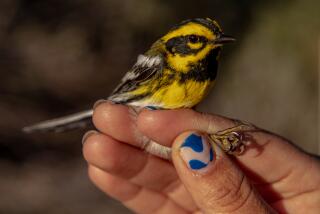These ‘babbler’ birds could shed light on human language
- Share via
Move over, parrots. Here’s another bird with some impressive “language” skills: The chestnut-crowned babbler. Scientists studying the social birds have discovered that they can rearrange meaningless sounds in their calls to form different, meaningful messages.
The findings, described in the journal PLOS Biology, may shed light on how the features of human language came to be.
“Our results indicate that the capacity to rearrange meaningless sounds in order to create new signals occurs outside of humans,” the authors wrote, and could hint at “a potential early step towards the generative phonemic system of human language.”
One of the fundamental abilities that sets humans apart from other animals is language -- the ability to string meaningless little sounds together to communicate complex ideas to one another.
Scientists have long studied different animals, from apes to zebra finches, for hints about the evolution of language abilities. And they’ve found a few commonalities here and there.
“For example, Campbell’s monkeys (Cercopithicus cambelli) produce two predator-specific alarm calls that are each modified in a predictable way into more general disturbance calls upon addition of the same suffix,” the authors wrote.
But scientists haven’t been able to find evidence for a fundamental property of human language: the ability to take meaningless sounds and rearrange them to have entirely different meanings. Take the sounds a, t and b – you can arrange them like b-a-t to mean a thing you swing to hit a ball, or t-a-b to mean the thing you open at a bar and later regret, or you can just use two of those sounds to say a-t, which is a handy little preposition in English. This “phonemic” power, the study authors say, has long been thought a particular trait of human communication.
“A major question in language evolution is how its generative power emerged,” the study authors wrote. “This power, which allows the communication of limitless thoughts and ideas, is a result of the combinatorial nature of human language.”
Hints of that, however, seem to lie in the calls of the chestnut-crowned babbler, a social, roughly 2-ounce bird that lives in the Australian Outback. These birds have 15 different calls for specific situations, but three pairs of those calls have a very unusual quality -- they actually seem to share similar sounds that been rearranged.
That’s pretty unusual, because while many bird species are clearly able to string together different sounds to make a beautiful song, those songs generally don’t have a specific meaning (beyond the basic “alarm!” or “Look how attractive I am!” type calls). And those sounds can’t be rearranged to change the song’s general message.
So something different was happening in the three song pairs in the babbler’s repertoire. Take two sounds, which are referred to as A and B. While flying, the birds would call out, “AB!” But when they were back at the nest and feeding chicks, they said, “BAB!” The flight call and the feeding call seem to have the same sounds, just in a different arrangement.
To learn more, the scientists first analyzed the two songs in this particular pair, to verify that they were indeed the exact same sounds (and that there was not some subtle difference that the birds were able to detect). When the researchers played the songs back to the babblers, the birds could clearly distinguish between the two -- they would scan for airborne birds if they heard the flight call and look to the nest when they heard the feeding call.
Then, to make doubly sure, the researchers actually chopped up the As and Bs from each song and then rearranged them into the other song. Sure enough, a feeding call that was made out of sounds from the flight call made them look to the nest, and a flight call that was built out of sounds from the feeding call made them look skyward. “To our knowledge, this is the first demonstration that animals have the basic capacity to use phoneme-like contrasts to derive qualitatively new meaning, a basic component of phoneme structuring,” the authors wrote.
The birds may do this for a simple reason: If you need to say something new, it’s easier to rearrange existing sounds in your repertoire than it is to come up with whole new sounds.
This ability, however, is extremely limited -- the two sounds A and B could theoretically be used to make all kinds of calls: AB, ABA, BABA, BAB, BA and so on. But the babblers use them to make only two different calls, so it’s unclear if there’s much underlying phonological complexity at work.
“Further experiments are now required to determine exactly how babblers compute and perceive the elements from the two calls,” the authors wrote. “More generally, further evidence for the use and manifestation of phonemic systems in animals is required; we propose that such systems will be most operant in the short-range communication of vocally constrained, social animals.”
Follow @aminawrite for more science news from the animal kingdom.







